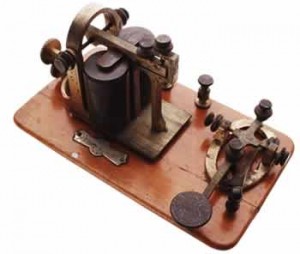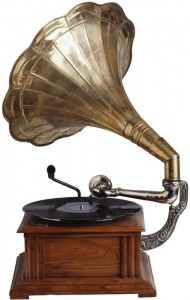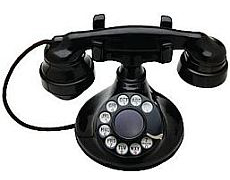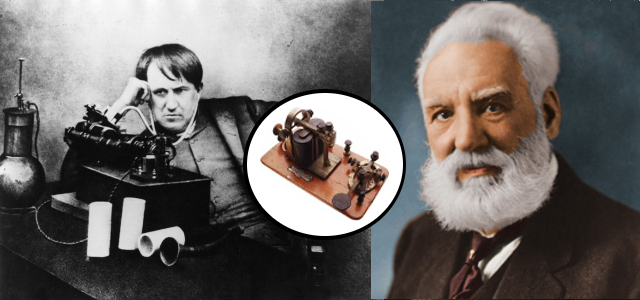It should come as no surprise that many of the concepts and procedures that we take for granted in the audio industry had their beginnings and subsequent refinements in the telephone industry. The telephone, in turn, was a direct outgrowth of telegraphy.
Joseph Henry (1797-1878), while serving as a professor of philosophy at the College of New Jersey (now Princeton University), performed a number of experiments with electromagnets that resulted in the first workable electromagnetic telegraph. Henry thought the phenomenon was interesting but made no particular effort to commercialize the results of his experiments. Because of his work in defining the characteristics of self-inductance, he was honored by having the unit of inductance named after him, i.e., the henry. He later (after 1846) became the first secretary and director of the Smithsonian Institution.
Long-Distance Communication

The telegraph, using the transmission of an electrically generated series of dots and dashes, was not only the first method that allowed communications over long distances, but was what we would consider nowadays to be the first use of a bit data stream for communication purposes. Some 10 years after Henry’s experiments, the American portraitist Samuel Finley Breese Morse developed a “language” consisting of dots and dashes and spacing that could be transmitted and received over a single wire (ground was the return path). Interestingly, Morse envisioned a system that would punch holes in a paper tape at the receiving end but still required that a telegrapher transmit the signal by manually inputting the “code” with a key that alternatively made and broke the electrical circuit. The paper punch apparatus fell into disuse as telegraphers learned to read the code by listening to the audible sound produced when the electromagnet’s relay armature struck the pole piece. The punched paper tape concept was to be reborn some 80 years later with the development of the teletype. In 1844, Morse demonstrated his apparatus and the Age of Telegraphy had its beginnings. Inasmuch as Morse had built upon the work of Henry and Andre Ampere without giving either credit, his originality as the inventor of the telegraph is often questioned.
Telegraph wires were quickly strung in countries around the globe and a massive industry was created. In the United States, private telegraph companies sprang into being and competed vigorously to capture business in this new communication era. In many countries outside of the United States, the telegraph service was established as a state-owned entity. In England, for example, this new communication service was placed under the control of the Royal Mail Service. To meet the needs of the rapidly emerging telegraph industry, a host of contractors and suppliers were formed to produce and install this newfangled technology. One of the more successful enterprises that sought to provide telegraph apparatus was the Chicago IL firm of GrayBar. The Barnesville OH-born inventor Elisha Gray (1835-1901) was the “Gray” part of this enterprise. Gray was subsequently to be a major player in the “Telephone Wars” of the 1880s and 1890s.
Inventors of the time turned their inventive genius towards developing a ‘harmonic telegraph’ that could send different bands of audible tones over a single wire.
One of the fundamental problems with this new technology was that only one message could be sent at a time over the single wire. Hence, if you wanted to send a message from Boston to New York while at the same time sending a message from New York to Boston, you needed two wires to handle the simultaneous traffic. As the popularity of this communication method grew, and as competition steadily reduced tariff rates, telegraph companies could only respond by stringing more wires. There was an intense interest in increasing the systems’ capacities without adding more and more iron wire. Inventors of the time, including Gray and Alexander Graham Bell (1847-1922), turned their inventive genius towards developing a “harmonic telegraph” that could send different bands of audible tones over a single wire. These early attempts to send multiple signals over a single wire were of no avail and it would be many years later before the principle of signal multiplexing would be successfully introduced.
Development Of The Telephone
A German experimenter by the name of Philipp Reis (1834-1874) had produced a single-point telegraph receiver in 1860 which was capable of sending and receiving tones but was not suitable for voice transmission. Reis considered his work as scientific in nature and could not foresee any commercial value for the device. His analysis was correct, in that the device was never commercially employed. However, his experimental device was the stepping stone to the development of the telephone transmitter. Interestingly, Reis choose to call his device a telephone. The name had been coined earlier, when, in 1796, another German had used the word, which was derived from the Greek roots meaning “far-speaking.”
It was during his experiments seeking to perfect a harmonic telegraph on that fateful day of June 2, 1875, when Bell and his equally youthful assistant Watson (both men were in their twenties) were to discover that plucked tones on their apparatus constituted the successful transmission of audible sound. As Bell’s biographer (Bruce, Robert V., Bell: Alexander Graham Bell and the Conquest of Solitude, Boston, Toronto, 1973) was to say, Bell was clever enough to realize that the means for transmission of intelligent speech had been realized and “its wise father knew his child.”
Both Bell and Edison realized how enormously profitable the commercialization of the telephone was to become.
The developments and exploits of both Bell and Thomas Alva Edison (1847-1931) have been well documented in several excellent books. Edison did have his dark side and engaged in what by today’s standards we would consider very devious business practices. For example, Edison served as the chief engineer for Western Union while simultaneously serving as a director for the Postal Telegraph, a major Western Union competitor. Elisha Gray earned a place in the history books when he filed his patent caveat for the telephone just hours after the Bell patent was filed. There was a considerable degree of controversy over the assignments of these patents: with some suggesting that Bell and the U.S. Patent Office had acted improperly. These issues and counter-issues were heatedly debated during the subsequent Telephone Wars.
The Telephone Wars
Both Bell and Edison realized how enormously profitable the commercialization of the telephone was to become. Thus ensued the Telephone Wars that were fought through the courts for twenty years, until finally in 1898 Bell was awarded rights to the invention of the telephone. In a complicated settlement of the issue, Edison and his entangled relationships with the telegraph companies were ordered to exit the telephone business. Thus, the Bell System had clear title to pursue this lucrative business.

For those of us in the audio industry, Edison is also recognized as the inventor of the phonograph, which sparked the creation of the recording industry. This endeavor was also to be surrounded by acrimony between the very stubborn, combative Edison and others such as Emile Berliner and A. G. Bell’s cousin Chester Bell.
Bell, Edison and others involved in the early development of telephone technology were not scientists in the classic mold. By-and-large they were experimenters (i.e. inventors) with little bent for, or knowledge in, physics or mathematics. As Lord Rayleigh was to comment during his presidential address to the British Association in Montreal in 1884, “The beautiful inventions of the telephone and the phonograph, although in the main dependent on principles long since established, have imparted a new interest to the study of acoustics.” In the same address he later added, “The theory of its [the telephone’s] operation is still in some respects obscure, as is shown by the comparative failure of the many attempts to improve it….” (emphasis added).
Edison held an openly derisive opinion of physicists and mathematicians. Bell, like his father and grandfather, was an elocutionist with a prime interest in helping the deaf to hear. When Bell was to lament that he lacked understanding of electrical principles, his mentor Joseph Henry was given to retort, “Then you had best learn.”
So, as the twentieth century dawned, given a clear court ordered mandate, the Bell System was provided the opportunity to expand the fledgling telephone industry into what was to become an all-encompassing North American network. However, with this opportunity came the daunting task of expanding from a point where one transmitter could communicate with one receiver over one pair of wires into a network that could be used to communicate between virtually any individual equipped with a telephone instrument and virtually any other similarly equipped individual.
Building A National Telephone Network
Where indeed was the newly formulated Bell System to locate and employ the engineers, the technicians and the army of installers that would be required to tackle this formidable task? During the twenty some-odd years since the introduction of a primitive version of the telephone and the subsequent, court directed, clear cut ascendancy of the Bell System, Bell and his associates had worked diligently to improve the transmission characteristics of the telephone instrument. To Edison’s credit, he developed a much-improved transmitter which was adopted as a standard for the telephone instrument. Nevertheless, much work was still required to reach a point where the system would be dependable and could provide a usable degree of audibility and intelligibility.
Bell, Edison and others involved in the early development of telephone technology were not scientists in the classic mold. They were experimenters with little bent for, or knowledge in, physics or mathematics.
Not that many years before, Edison had been asked why sound appears louder at closer proximity and less loud at further distances. Edison, ignorant of the inverse-square laws of physics, responded that it was a “curious” matter.
At the time no standard measurements of sound intensity had been developed—the decibel (dB) was at least two decades away from formulation. Rayleigh had perfected the means to measure the intensity of sound. However, he had not quantified a practical system of measurement for sound intensity.

If the period from 1872 until 1900 was the domain of the experimenter/inventor in telephony, the period that followed was recaptured by physicists and scientific minds. People such as Fletcher, Wente, Maxwell and Armstrong examined the nature of transmission principles and formulated the essential mathematical and technological principles that enabled the fledgling telephone industry to cope with the demands of connecting its expanding multitude of users.
In light of the monopolistic control that the courts had given it, the Bell System had a clear field for the development of providing telephone services to the North American market. Thus, the company eventually had more than ample resources to devote to further research and development in the expansion of the network.
These resources would lead to the development of Western Electric, Electrical Resources Products (ERPI) and ultimately Bell Laboratories. Out of these entities would subsequently develop such advancements as the public address system, “talking” pictures and the refinement of sound recording.
It is from these beginnings in telephony and motion picture sound that the audio industry as we know it, including the units used to measure both acoustic and electrical audio signals, developed.
Western Electric was very much in the forefront during these earlier developments. However, RCA was a strong contender. As Western Electric strove for supremacy in the motion picture industry, RCA countered by acquiring the RKO (Paramount) production studios. For a few years, RKO films could not be shown (for technical reasons) in Western Electric equipped theaters and vice versa.
At the same time that American engineers were striving to solve these problems, their counterparts in Europe were hard at work on very similar issues. Siemens, Ericson and Phillips were very much involved in the advancement of telephony principals. It is from these beginnings in telephony and motion picture sound that the audio industry as we know it, including the units used to measure both acoustic and electrical audio signals, developed.
This article was originally published in the June 2000 issue of Sound & Communications.
Click here for more of Sound & Communications’ “Industry Pioneers” series.
